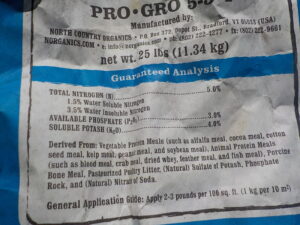This Is a Good Time to Do Soil Testing and Soil Improvement
Posted on Tuesday, March 22, 2022 · Leave a Comment
This is a good time to beat the rush and get your soil tested so that you can improve your soil before you begin planting.

A simple pH test kit costs under $10 and do fine
Most New England states have soil testing labs available to gardeners. Finding one is as simple as searching for “Soil testing lab near me” in your browser. Your first choice should probably be one run by the state university Extension Service. Most offer a variety of options as to what is tested, and their websites will explain your options, what each costs, and how to collect a sample. Most tests require one or two cups of air-dried soil free of roots and rocks.
Most State labs are very busy in spring, and a 14 to 21 day wait is typical. If you are in a rush to get your soil test results, you might try Logan Labs, a commercial lab in Ohio. They can usually e-mail test results in a few days and also have a soil scientist available to talk to you (for a fee) to make recommendations.
Unless you live where there are natural limestone or marble deposits – parts of Vermont, for example – your soil is probably acidic. Why? Coal fired power plants send sulfur into the air, and it reacts with water to form sulfuric acid that is dropped by the rain. Most plants do best with a soil pH between 6.0 and 6.8. A pH of 7.0 is neutral, and above that is alkaline. Soils rich in organic matter and microorganisms tend to buffer the soil pH, making it less acidic.

Organic fertilizers generally are slow-release fertilizers
Soils are composed of three things, basically: ground up rock is about 45%, air is about 50% and organic matter about 5%. The particle size of the rock component is what determines soil texture: big particles are in sand, medium particles in silt, and very fine particles make up clay. A good soil has particles of all 3 sizes, but is mostly silt.
You can see what is in your soil by filling a quart jar half full of water, and adding a couple of cups of soil, and then shaking it well. Sand will drop to the bottom pretty much immediately, and silt will drop next. Finally, after 24 hours or so, your clay will form a layer. Each will probably be a different color, and quite obvious. Organic matter often floats on the surface, but generally mixes with the silt layer.
Clay holds onto soil minerals and moisture the best, but it can stay soggy and also get compacted. Sand particles are not electrically charged, so they don’t hold onto minerals like clay or silty soils – but the sand helps with drainage. You can get a feel for your soil by rubbing it between your thumb and a finger after wetting it. Clay soil is sticky. You can feel the grains in a sandy soil.
If your soil has a pH of 6.0 or less, you should add some garden lime or wood ashes to “sweeten it”. If you get a soil test, it should tell you how many pounds of lime to add as expressed in pounds per 100 square feet – a 10 ft. by 10ft. area. I weighed a quart of garden lime in a yogurt container and it weighs a little over 3 pounds. Wood ashes are about equivalent in what they do. But this isn’t rocket science – you don’t have to be precise.
Lime is ground limestone, and is sold in bags at the garden center. It comes as powdered lime or pelletized lime, which is less messy. If you buy powdered lime, wear a mask when spreading it so you don’t inhale it.
All fertilizers add nitrogen (N), phosphorous (P) and potassium (K). The amount of each is expressed as a number that is the percentage of the active ingredient by weight. A 10-10-10 fertilizer has 10 % of each, and 70% filler. The minerals in chemical fertilizers are in the form of salts, and using too much can damage roots. The salts in chemical fertilizer are water soluble and can be dissolved and washed away in heavy rains.
Organic fertilizers, on the other hand, are made from natural ingredients and minerals from ground rocks. My favorite organic fertilizer, Pro-Gro, is made in Vermont and has things such as peanut meal, cotton seed meal, ground oyster shells, feather meal, crab meal, dried blood (for nitrogen) and rock phosphate. I like to compare it to a 7-course meal for plants.

Add fertilizer and compost to hole and stir in before planting scaled
The ingredients of an organic fertilizer mostly need to be digested by microorganisms found in the soil, and then shared with green plants. They are gentler, and slow to release their goodies. The mineral content of Pro-Gro is listed as 5-3-4, which is lower than most chemical fertilizer, but offers all those micronutrients not found in chemical fertilizers.
Of course you can go the old fashioned way and add animal manures to improve your soil. They work, but some may also introduce weed seeds. I don’t recommend using fresh horse or cow manure because of that, but manure that is a year or two old has fewer seeds. Rabbit, sheep and goat manure has fewer weed seeds, and they add plenty of organic matter that helps with texture and tilth.
If you add compost to your garden and work it in, it will become more biologically active – full of beneficial microorganisms. It will drain much better, but hold moisture better, too.
Having good soil is one of the keys to being a good gardener. Perhaps testing and improving your soil will help you to have that elusive green thumb. It’s worth trying.





